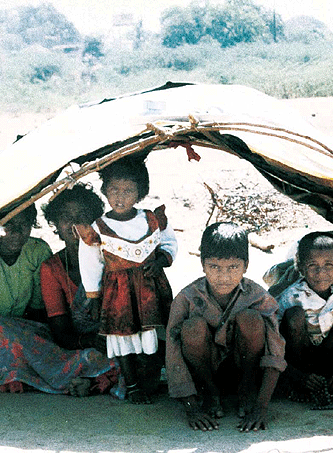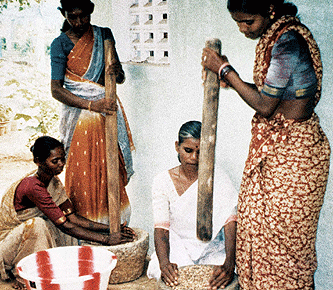 COUNTRY OF ORIGIN
COUNTRY OF ORIGINThe raincoat package for soil, plant, animal and human health
Introduction
The Raincoat Package is a kit developed by the Herbal Folklore Research Centre (HFRC), Tirupati, India, for treating soil, plants, animals and human beings with parts of the Neem plant (Azadirachta indica A Juss). Neem is a large evergreen tree that grows 10 to 11 metres tall. It bears small white flowers in auxiliary branches and green or yellow fruits, each containing one seed; the seed contains up to 40% essential oil. All parts of the tree possess healing properties.
Indians have known about the medicinal properties of Neem since time immemorial: it is a sacred tree, commonly used during religious ceremonies. In the Vedas, Neem was called the sarvaroganivarini (“one that cures all ailments and ills”). Mythology also focuses on its curative properties, and people worship the tree to avert ill luck and diseases. The earliest Sanskrit medical writings refer to the benefit of Neem fruits, seeds, oils, leaves, roots and bark, each of which have been used in the Indian Ayurvedic, Siddha and Unani systems of medicines to combat skin disorders, stomach ulcers, chicken pox, leprosy, jaundice, boils, wounds, heat rash and other ailments. During epidemics people take baths in water boiled with Neem leaves to ward off illness. Neem plant parts are widely used by indigenous people for treating mother earth, plants, animals and human beings alike. Neem is such a common and useful tree in tropical regions that rural and tribal populations in India call it “the village pharmacy”.
Modern medicine has confirmed Neem’s curative power. Its leaves, flowers, seeds, bark and oil are used for a variety of purposes, and the tree’s presence has been deemed helpful for soil and air. The use of Neem in agriculture can also serve as an alternative to chemical pesticides. Treatment methods and dosages vary only according to who or what is using the plant for what purposes.
Dr. S. Vedavathy has worked for years with tribal groups in India to strengthen their traditional knowledge base through awareness programs and training in practical applications for indigenous knowledge. A decade ago, when there were still relatively few sources of information and field studies on traditional innovations, she observed the groups’ innovative uses of the wonder tree Neem. Between 1994 and 1997, with the financial assistance of Canada’s International Development Research Centre (IDRC), she documented the local health traditions and folk wisdom of the indigenous people in the Chittoor district in the state of Andhra Pradesh, India, focussing on the importance of Neem for both agriculture and primary health care. The innovative and multiple uses of the Neem plant led her to develop the Raincoat Package.
There is no other compound, whether synthetic or natural, with as many and such safe applications as Neem has. Its use forms part of the traditional knowledge of tribal groups and rural communities in India and ought to be more widely known, as Neem is low-cost, widely available and socially responsible.
Just as a raincoat may be used to protect any thing from rain, the Raincoat Package developed by the HFRC provides for all kinds of uses for the Neem plant. One Raincoat Package contains all five parts of the Neem tree, i.e. bark, root, fruit, flower and leaves. All that is required are expanded and innovative ways to use the plant parts for particular conditions. The Raincoat Package uses the Neem seeds to combat insects and other pests, and Neem leaves to protect grain in storage, while the residual material is used as a biofertilizer (compost) for crops. In addition, the seed extract, oil and leaves are used for treating itch (scabies), cuts, scrapes, rashes and inflammations in a traditional manner. The Raincoat Package has been used with excellent results in rural areas of the Tirupati District for plant protection: it is eco-friendly, low-cost and multi-purpose.
DOWNLOAD THE BROCHURE PDF
english (0.7 MB)spanish (0.7 MB)
albanian (0.8 MB)
ONLY TEXT
•The raincoat package in practice







